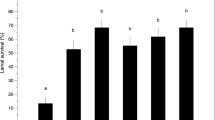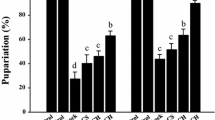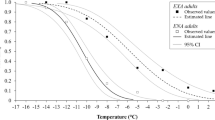Abstract
The winter-active Diamesa mendotae Muttkowski (Diptera: Chironomidae) is freeze intolerant in the adult stage with a low mean supercooling point (SCP) of ~−20 °C. However, cold-hardiness strategies for immatures of this species are unknown. In this study, we measured SCP values for D. mendotae larvae, pupae and adults using surface-contact thermometry. In addition, the lower lethal temperature (LLT) was determined for the larval stage. The mean SCPs for larvae (−7.4 °C) and pupae (−9.1 °C) were relatively high compared to adults (−19.7 °C). Our results indicate that the larvae of D. mendotae are freeze tolerant with a LLT99 (−25.4 °C), ~−10 °C lower than their minimum SCP (−15.6 °C). Freeze tolerance in these larvae may be a strategy to provide protection from short-term exposures to ice crystals or to permit diapause within frozen substrates. The change in cold-hardiness strategy from freeze tolerant to freeze intolerant between the larval and adult stages of this species is likely a result of the different habitats occupied by these two life stages.
Similar content being viewed by others
References
Abbott W. S. (1925). A method of computing the effectiveness of an insecticide. Journal of Economic Entomology 18: 265–267
Adler P. H., Currie D. C. and Wood D. M. (2004). The black flies (Simuliidae) of North America. Cornell University Press, Ithaca
Andrews D. and Rigler F. H. (1985). The effects of and Arctic winter on benthic invertebrates in the littoral zone of Char Lake, Northwest Territories. Canadian Journal of Zoology 63: 2825–2834
Ashton G. D. (1979). River ice. American Scientist 67: 38–45
Bale J. S. (1989). Cold hardiness and overwintering of insects. Agricultural Zoology Reviews 3: 157–192
Bale J. S. (1991). Implications of cold hardiness for pest management. In: Denlinger, D. L. (eds) Insects at Low Temperature, pp 461–498. Chapman & Hall, New York
Baust J. G. and Edwards J. S. (1979). Mechanisms of freezing tolerance in an Antarctic midge, Belgica antarctica. Physiological Entomology 4: 1–5
Baust J. G. and Lee R. E. (1981). Environmental “homeothermy” in an Antarctic insect. Antarctic Journal of the United States 15: 170–172
Baust J. G. and Rojas R. R. (1985). Review - insect cold hardiness: facts and fancy. Journal of Insect Physiology 31: 755–759
Berg M. B. and Hellenthal R. A. (1991). Secondary production of Chironomidae (Diptera) in a north temperate stream. Freshwater Biology 25: 497–505
Block W (1991). To freeze or not to freeze? invertebrate survival of sub-zero temperatures. Functional Ecology 5: 284–290
Block W., Erzinclioglu Y. Z. and Worland M. R. (1988). Survival of freezing in Calliphora larvae. CryoLetters 9: 86–93
Carrillo M. A. (2006). Lower lethal temperature for adult male Diamesa mendotae Muttkowski (Diptera: Chironomidae), a winter-emerging Diamesinae. Aquatic Insects 28: 57–66
Brundin L. (1966). Transantarctic relationships and their significance, as evidenced by chironomid midges with a monograph of the subfamilies Podonominae and Aphroteniinae and the austral Heptagyiae. Kunglica Svenska Vetenskapsakademiens Handlingar 11: 1–472
Carrillo M. A. and Cannon C. A. (2004a). Effect of sex and age on the supercooling point of the winter-active Diamesa mendotae Muttkowski (Diptera: Chironomidae). Aquatic Insects 26: 243–251
Carrillo M. A., Kaliyan N., Cannon C. A., Morey R. V. and Wilcke W.␣F. (2004b). A simple method to adjust cooling rates for supercooling point determination. CryoLetters 25: 155–160
Carrillo M. A., Cannon C. A., Wilcke W. F., Morey R. V. and Hutchison W. D. (2005a). Relationship between supercooling point and mortality at low temperatures in Indianmeal moth (Lepidoptera: Pyralidae). Journal of Economic Entomology 98: 618–625
Carrillo M. A., Heimpel G. E., Moon R. D., Cannon C. A. and Hutchison W. D. (2005b). Cold hardiness of Habrobracon hebetor (Say) (Hymenoptera: Braconidae), a parasitoid of pyralid moths. Journal of Insect Physiology 51: 759–768
Danks H. V. (1971). Overwintering of some north temperate and arctic Chironomidae. The Canadian Entomologist 103: 1875–1910
Frisbie M. P. (1997). Inoculative freezing and the problem of winter survival for freshwater macroinvertebrates. Journal of the North American Benthological Society 16: 635–650
Miller L. K. and Oswood M. W. (1993). Ecological adaptations of aquatic macroinvertebrates to overwintering in interior Alaska (U.S.A.) subarctic streams. Canadian Journal of Zoology 71: 98–108
Koch R. L., Carrillo M. A., Venette R. C., Cannon C. A. and Hutchison W. D. (2004). Cold hardiness of the multicolored Asian lady beetle (Coleoptera: Coccinellidae). Environmental Entomology 33: 815–822
Kohshima S. (1984). A novel cold-tolerant insect found in a Himalayan glacier. Nature 310: 225–227
Langton P. H. (1995). Chap 8: The pupa and events leading to eclosion. In: Armitage, P. D., Cranston, P. S. and Pinder, L. C. V. (eds) The Chironomidae: Biology and Ecology of Non-biting Midges, pp 169–193. Chapman & Hall, London
Leather S. R., Walters K. F. A and Bale J. S. (1993). The Ecology of Insect Overwintering. Cambridge University Press, Cambridge
(1989). Insect cold-hardiness: to freeze or not to freeze. BioScience 39: 308–313
(1991). Principles of insect low temperature tolerance. In: Denlinger, D. L. (eds) Insects at Low Temperature, pp 17–46. Chapman & Hall, New York
Lencioni V. (2004). Survival strategies of freshwater insects in cold environments. Journal of Limnology 63: 45–55
MacAnova, 2002. MacAnova for Windows, version 4.12. University of Minnesota, School of Statistics. Available online at: http://www.stat.umn.edu/macanova/download.html
Moore M. V. (1991). Surviving the big chill: overwintering strategies of aquatic and terrestrial insects. American Entomologist 37: 111–118
Nolte U. and Hoffman T. (1992). Fast life in cold water: Diamesa incallida (Chironomidae). Ecography 15: 25–30
Olsson T. I. (1981). Overwintering of benthic macroinvertebrates in ice and frozen sediment in a North Swedish river. Holarctic Ecology 4: 161–166
Oswood M. W. and Miller L. K. (1991). Overwintering of freshwater benthic macroinvertebrates. In: Denlinger, D. L. (eds) Insects at Low Temperature, pp 360–375. Chapman & Hall, New York
Ring R. A. (1989). Intertidal Chironomidae of B.C., Canada. Acta Biologica Debrecen Oecologica Hungarica 3: 275–288
Salt R. W. (1953). The influence of food on cold hardiness of insects. The Canadian Entomologist 85: 261–269
Salt R. W. (1961). Principles of insect cold-hardiness. Annual Review of Entomology 6: 55–74
(1998). Statistical Analysis System, version 6.12. SAS Institute, Cary
Scholander P. F., Flagg W., Hock R. J. and Irving L. (1953). Studies on the physiology of frozen plants and animals in the arctic. Journal of Cellular Comparative Physiology 41: 1–56
(2001). SigmaPlot 2001 for Windows, version 7.0. SPSS Inc, Chicago
Sinclair B. J. (1999). Insect cold tolerance: how many kinds of frozen?. European Journal of Entomology 96: 157–164
Sømme L. and Østbye E. (1969). Cold-hardiness in some winter active insects. Norsk Entomologisk Tidsskrift 16: 45–48
Sømme L. (1982). Supercooling and winter survival in terrestrial arthropods. Comparative Biochemistry and Physiology A: Physiology 73: 519–543
Southwood T. R. E. and Henderson P. A. (2000). Ecological Methods. Blackwell Ltd, Oxford
Storey K. B. and Storey J. M. (1997). To freeze or not to freeze - the dilemma for life below 0 °C. The Biochemist 19: 8–13
Wülker W. and Götz P. (1968). Die Verwendung der Imaginalscheiben zur Bestimmung des Entwicklungszustandes von Chironomus-Larven (Dipt.). Zeitschrift für Morphologie der Tiere 62: 363–388
Young R. M. (1969). Field observations on a midwinter breeding flight of Diamesa arctica (Diptera: Chironomidae). Annals of the Entomological Society of America 6: 1204
Zachariassen K. E. (1985). Physiology of cold tolerance in insects. Physiological Reviews 65: 799–832
Zachariassen K. E. and Kristiansen E. (2000). Ice nucleation and antinucleation in nature. Cryobiology 41: 257–279
Zachariassen K. E., Kristiansen E. and Pedersen S. A. (2004). Inorganic ions in cold-hardiness. Cryobiology 48: 126–133
Author information
Authors and Affiliations
Corresponding author
Rights and permissions
About this article
Cite this article
Bouchard, R.W., Carrillo, M.A., Kells, S.A. et al. Freeze tolerance in larvae of the winter-active Diamesa mendotae Muttkowski (Diptera: Chironomidae): a contrast to adult strategy for survival at low temperatures. Hydrobiologia 568, 403–416 (2006). https://doi.org/10.1007/s10750-006-0200-6
Received:
Revised:
Accepted:
Published:
Issue Date:
DOI: https://doi.org/10.1007/s10750-006-0200-6




